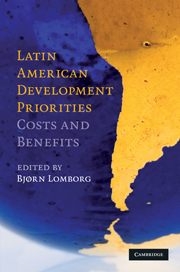Book contents
- Frontmatter
- Contents
- List of figures
- List of tables
- List of contributors
- Acknowledgments
- Abbreviations and acronyms
- Expert panel findings
- Introduction
- Democracy
- Education
- Employment and social security
- Environment
- Fiscal problems
- Health
- Infrastructure
- Poverty
- Public administration
- Violence and crime
- 10 Violence and crime in the LAC region
- 10.1 Violence and crime: an alternative view
- Conclusion
10 - Violence and crime in the LAC region
Published online by Cambridge University Press: 05 June 2012
- Frontmatter
- Contents
- List of figures
- List of tables
- List of contributors
- Acknowledgments
- Abbreviations and acronyms
- Expert panel findings
- Introduction
- Democracy
- Education
- Employment and social security
- Environment
- Fiscal problems
- Health
- Infrastructure
- Poverty
- Public administration
- Violence and crime
- 10 Violence and crime in the LAC region
- 10.1 Violence and crime: an alternative view
- Conclusion
Summary
Challenges
Background
The public survey that was conducted by the IDB for the Copenhagen Challenge process identified the problem of “crime and violence” as one of the areas of major concern in the LAC region. In particular, the following items were identified (in descending or perceived priority): (a) high incidence of crime, (b) drug trafficking, (c) proliferation of violent youth gangs, (d) pervasiveness of money laundering, and (e) frequency of domestic violence. In conducting the research for this chapter, we evaluated the nature of the evidence on the extent to which these perceived issues would rise to the level of being “significant,” as well as the evidence on “what works” and what the benefits and costs are from programs that have been shown to be effective.
Setting the boundaries of our analysis was a difficult task, but one that we needed to do in order to arrive at a document that would be of value to policymakers. For example, while most incidents of crime and violence are essentially “local,” the causes and potential solutions to crime may lie well outside the local or even national jurisdiction. This is true globally – where many types of crimes are clearly of a global character and require more than local solutions.
- Type
- Chapter
- Information
- Latin American Development PrioritiesCosts and Benefits, pp. 621 - 679Publisher: Cambridge University PressPrint publication year: 2010



